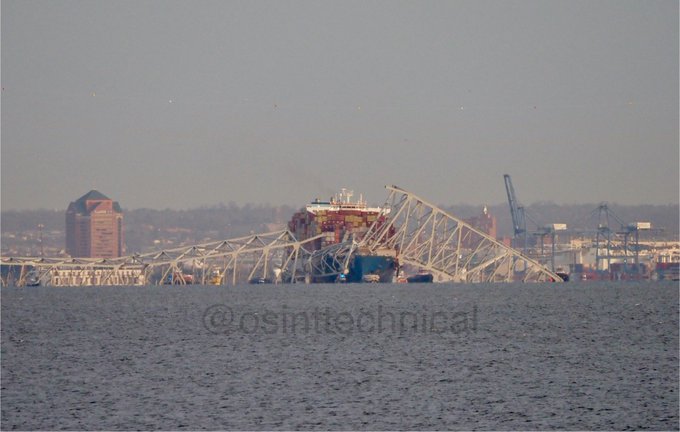There’s ships, and then there’s SHIPS.
Momentum is mass times velocity. Say we assume this thing was 150,000 tons travelling at 3mph, this suggests it has the same momentum as 150 tons moving at 3,000mph. Force is equal to change in momentum over time, so when you look at the ship impacting the bridge, you have to imagine it delivering the same level of power that is wrapped up in 150 tons at 3,000mph. I’m sure things are nowhere near that simple, but that gives a bit of an intuition of the sort of forces at play.
Crazy video
Who generally uses this bridge? Every time I’ve driven through Baltimore, GPS takes me via the tunnel. This bridge seems a little out of the way and connecting more sparsely populated areas.
There are some pretty worried engineers right now.
Is it the engineers’ fault if they build a bridge that falls down when a ship smashes into it? This wasn’t a case of the bridge falling down in the wind because of bad design.
I’m presuming he means the engineers who designed the ship. It seems not great if a gigantic ship can have a power outage which renders it unsteerable, if that is what happened.
I don’t know the answer to that obviously but I am sure the designers and builders are double checking everything to make sure there were no errors. The bridge would have been designed with a collision tolerance so really the question is did it exceed that.
This too.
IANA structural engineer but I strongly doubt there is any man-made vertical structure on the planet that would survive being rammed by a loaded container ship.
Ya probably true. I am going to ask some guys at work today. I have like 10 bridge engineers down the hall from me.
Let us know, my assessment is the same as Chris’. This ship would have brought down nearly any structure put in front of it
Ya, if they engineered bridges to withstand forces like that, we as a species could have afforded to build about 3 of them by now.
I don’t think they would be designed to not take damage. I’m more curious if the design would prevent a total collapse like this.
Me neither! I have read about some more extreme cases where an engineering failure resulted in a bridge or other structure collapsing under “normal” conditions. In this case, I have no idea what the expectations are on engineers to make their structures resilient to unexpected but plausible stresses. One the one hand, it would be obviously good if bridges could withstand a collision with a boat, because accidents happen. On the other hand, it also seems reasonable that an engineer could build a bridge that doesn’t have to withstand such a collision if the cost of doing so is prohibitively high. As a crude example, if a driver on the highway swerves into my lane and hits my car head on, my car will fail and I have a good chance of dying. Is that the car engineer’s fault? Obviously no one holds car engineers to that high of a standard, even though the collision is a plausible event.
Yeah, for public infrastructure clearly the profession of engineers and the regulators will have to work together to set where the line is. That isn’t something where a lay person could just intuit what the right compromises are. It would be based on decades of engineering science and legal experience, constantly updated for evolving technology.
This is the exact logic of all engineering decisions in terms of balancing risk with cost. It’s why engineers here wear a steel ring on thier pinky that symbolizes the steel from a bridge collapse to always remind them when signing a drawing that their duty is to balance those two things.
The MAGA bingo card on this will have: dem run cities, something about immigration (should be spending money on infrastructure instead of iPhones for illegals), something about crime in Baltimore, maybe some good old-fashioned “God is sending a message”.
